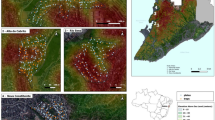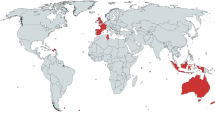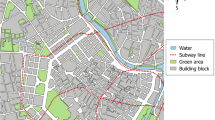Abstract
Norway rats (Rattus norvegicus) living in urban environments are a critical public health and economic problem, particularly in urban slums where residents are at a higher risk for rat borne diseases, yet convenient methods to quantitatively assess population sizes are lacking. We evaluated track plates as a method to determine rat distribution and relative abundance in a complex urban slum environment by correlating the presence and intensity of rat-specific marks on track plates with findings from rat infestation surveys and trapping of rats to population exhaustion. To integrate the zero-inflated track plate data we developed a two-component mixture model with one binary and one censored continuous component. Track plate mark-intensity was highly correlated with signs of rodent infestation (all coefficients between 0.61 and 0.79 and all p-values < 0.05). Moreover, the mean level of pre-trapping rat-mark intensity on plates was significantly associated with the number of rats captured subsequently (Odds ratio1.38; 95 % CI 1.19–1.61) and declined significantly following trapping (Odds ratio 0.86; 95 % CI 0.78–0.95). Track plates provided robust proxy measurements of rat abundance and distribution and detected rat presence even when populations appeared ‘trapped out’. Tracking plates are relatively easy and inexpensive methods that can be used to intensively sample settings such as urban slums, where traditional trapping or mark-recapture studies are impossible to implement, and therefore the results can inform and assess the impact of targeted urban rodent control campaigns.




Similar content being viewed by others
References
Allen LR, Engeman RM (2014) Evaluating and validating abundance monitoring methods in the absence of populations of known size: review and application to a passive tracking index. Environ Sci Pollut Res Int. doi:10.1007/s11356-014-3567-3
Barocchi MA, Ko AI, Ferrer SR, Faria MT, Reis MG, Riley LW (2001) Identification of new repetitive element in Leptospira interrogans serovar copenhageni and its application to PCR-based differentiation of Leptospira serogroups. J Clin Microbiol 39:191–195. doi:10.1128/Jcm.39.1.191-195.2001
Borchers D, Buckland S, Zucchini W (2002) Estimating animal abundance: closed populations. London
Brazil (2005) Ministry of health. epidemiological surveilance of infectious diseases. http://portal.saude.gov.br/portal/svs/area.cfm?id_area=451
Brown LE (1969) Field experiments on movements of apodemus sylvaticus L using trapping and tracking techniques. Oecologia 2:198–222. doi:10.1007/Bf00379159
Cavia R, Cueto GR, Suarez OV (2009) Changes in rodent communities according to the landscape structure in an urban ecosystem. Landsc Urban Plan 90:11–19. doi:10.1016/J.Landurbplan.2008.10.017
CDC (2006) Centers for disase control and prevention. Integrated pest management: conducting urban rodent surveys. US Department of Health and Human Services. vol 50. Atlanta
Childs JE, Krebs JW, Ksiazek TG, Maupin GO, Gage KL, Rollin PE, Zeitz PS, Sarisky J, Enscore RE, Butler JC, Cheek JE, Glass GE, Peters CJ (1995) A household-based, case–control study of environmental-factors associated with hantavirus pulmonary syndrome in the southwestern United-States. Am J Trop Med Hyg 52:393–397
Conceicao KS, Andrade MG, Louzada F (2013) Zero-modified Poisson model: Bayesian approach, influence diagnostics, and an application to a Brazilian leptospirosis notification data. Biom J 55:661–678. doi:10.1002/Bimj.201100175
Connors MJ, Schauber EM, Forbes A, Jones CG, Goodwin BJ, Ostfeld RS (2005) Use of track plates to quantify predation risk at small spatial scales. J Mammal 86:991–996. doi:10.1644/1545-1542(2005)86[991:Uotptq]2.0.Co;2
Costa F, Porter FH, Rodrigues G, Farias H, de Faria MT, Wunder EA, Osikowicz LM, Kosoy MY, Reis MG, Ko AI, Childs JE (2014a) Infections by leptospira interrogans, Seoul virus, and bartonella spp. Among Norway rats (Rattus norvegicus) from the urban slum environment in brazil. Vector Borne Zoonot Dis 14:33–40. doi:10.1089/Vbz.2013.1378
Costa F, Ribeiro GS, Felzemburgh RDM, Santos N, Reis RB, Santos AC, Fraga DBM, Araujo WN, Santana C, Childs JE, Reis MG, Ko AI (2014b) Influence of Household Rat Infestation on Leptospira Transmission in the Urban Slum Environment Plos Neglect Trop D 8 doi:ARTN e3338 DOI 10.1371/journal.pntd.0003338
Costa F, Wunder EA Jr, De Oliveira D, Bisht V, Rodrigues G, Reis MG, Ko AI, Begon M, Childs JE (2015) Patterns in leptospira shedding in Norway rats (rattus norvegicus) from Brazilian slum communities at high risk of disease transmission. PLoS Negl Trop Dis 9:e0003819. doi:10.1371/journal.pntd.0003819
Davis DE (1953) The characteristics of rat populations. Q Rev Biol 28:373–399
Davis DE, Emlen JT, Stokes AW (1948) Studies on home range in the brown rat. J Mammal 29:207–225. doi:10.2307/1375387
Davis S, Calvet E, Leirs H (2005) Fluctuating rodent populations and risk to humans from rodent-borne zoonoses. Vector Borne Zoonot Dis 5:305–314. doi:10.1089/Vbz.2005.5.305
de Masi E, Vilaca PJ, Razzolini MT (2009) Evaluation on the effectiveness of actions for controlling infestation by rodents in Campo Limpo region, Sao Paulo Municipality, Brazil. Int J Environ Health Res 19:291–304. doi:10.1080/09603120802592723
Dickman CR (1986) A method for censusing small mammals in urban habitats. J Zool 210:631–636
Drennan JE, Beier P, Dodd NL (1998) Use of track stations to index abundance of sciurids. J Mammal 79:352–359. doi:10.2307/1382872
Efford M (2004) Density estimation in live-trapping studies. Oikos 106:598–610. doi:10.1111/J.0030-1299.2004.13043.X
Emlen JT, Stokes AW, Davis DE (1949) Methods for estimating populations of brown rats in urban habitats. Ecology 30:430–442. doi:10.2307/1932446
Engeman RM, Witmer GW (2000) IPM strategies: indexing difficult to monitor populations of pest species Proc Vertebr Pest C:183–189
Flannery B, Pereira MM, Velloso LD, Carvalho CD, De Codes LG, Orrico GD, Dourado CMR, Riley LW, Reis MG, Ko AI (2001) Referral pattern of leptospirosis cases during a large urban epidemic of dengue. Am J Trop Med Hyg 65:657–663
Gardner-Santana LC, Norris DE, Fornadel CM, Hinson ER, Klein SL, Glass GE (2009) Commensal ecology, urban landscapes, and their influence on the genetic characteristics of city-dwelling Norway rats (Rattus norvegicus). Mol Ecol 18:2766–2778. doi:10.1111/j.1365-294X.2009.04232.x
Glass GE, Korch GW, Childs JE (1988) Seasonal and habitat differences in growth-rates of wild rattus-norvegicus. J Mammal 69:587–592. doi:10.2307/1381350
Glass GE, Johnson JS, Hodenbach GA, Disalvo CLJ, Peters CJ, Childs JE, Mills JN (1997) Experimental evaluation of rodent exclusion methods to reduce hantavirus transmission to humans in rural housing. Am J Trop Med Hyg 56:359–364
Glennon MJ, Porter WF, Demers CL (2002) An alternative field technique for estimating diversity of small-mammal populations. J Mammal 83:734–742. doi:10.1644/1545-1542(2002)083<0734:Aaftfe>2.0.Co;2
Himsworth CG, Bidulka J, Parsons KL, Feng AY, Tang P, Jardine CM, Kerr T, Mak S, Robinson J, Patrick DM (2013a) Ecology of leptospira interrogans in Norway rats (Rattus norvegicus) in an inner-city neighborhood of Vancouver, Canada. PLoS Negl Trop Dis 7, e2270. doi:10.1371/journal.pntd.0002270
Himsworth CG, Parsons KL, Jardine C, Patrick DM (2013b) Rats, cities, people, and pathogens: a systematic review and narrative synthesis of literature regarding the ecology of rat-associated zoonoses in urban centers. Vector Borne Zoonotic Dis 13:349–359. doi:10.1089/vbz.2012.1195
Himsworth CG, Jardine CM, Parsons KL, Feng AYT, Patrick DM (2014) The characteristics of wild Rat (Rattus spp.) populations from an inner-city neighborhood with a focus on factors critical to the understanding of Rat-associated zoonoses. Plos One 9:10.1371/journal.pone.0091654
Kajdacsi B, Costa F, Hyseni C, Porter F, Brown J, Rodrigues G, Farias H, Reis MG, Childs JE, Ko AI, Caccone A (2013) Urban population genetics of slum-dwelling rats (Rattus norvegicus) in Salvador, Brazil. Mol Ecol 22:5056–5070. doi:10.1111/mec.12455
Ko AI, Reis MG, Dourado CMR, Johnson WD, Riley LW, Grp SLS (1999) Urban epidemic of severe leptospirosis in Brazil. Lancet 354:820–825
Ko AI, Goarant C, Picardeau M (2009) Leptospira: the dawn of the molecular genetics era for an emerging zoonotic pathogen. Nat Rev Microbiol 7:736–747. doi:10.1038/nrmicro2208
Krojgaard LH, Villumsen S, Markussen MDK, Jensen JS, Leirs H, Heiberg AC (2009) High prevalence of Leptospira spp. in sewer rats (Rattus norvegicus). Epidemiol Infect 137:1586–1592. doi:10.1017/S0950268809002647
Lambert D (1992) Zero-inflated Poisson regression, with an application to defects in manufacturing. Technometrics 34:1–14. doi:10.2307/1269547
Lambropoulos AS, Fine JB, Perbeck A, Torres D, Glass GE, McHugh P, Dorsey EA (1999) Rodent control in urban areas - an interdisciplinary approach. J Environ Health 61:12–17
Landis JR, Koch GG (1977) The measurement of observer agreement for categorical data. Biometrics 33:159–174
Leslie PH, Davis DHS (1939) An attempt to determine the absolute number of rats on a given area. J Anim Ecol 8:94–113
Lord RD (1983) Rodent control programs: use of the inked tracking board method in Mexico. Bull Pan Am Health Organ 17:259–268
Lord RD, Vilches AM, Maiztegu JI, Hall EC, Soldini CA (1971) Frequency of rodents in habitats near Pergamino, Argentina, as related to junin virus. Am J Trop Med Hyg 20:338–342
Maciel EAP, de Carvalho ALF, Nascimento SF, de Matos RB, Gouveia EL, Reis MG, Ko AI (2008) Household transmission of leptospira infection in urban slum communities Plos Neglect Trop D 2 doi:10.1371/journal.pntd.0000154
Maskey M, Shastri JS, Saraswathi K, Surpam R, Vaidya N (2006) Leptospirosis in Mumbai: post-deluge outbreak 2005. Indian J Med Microbiol 24:337–338
McKelvey KS, Pearson DE (2001) Population estimation with sparse data: the role of estimators versus indices revisited. Can J Zool 79:1754–1765. doi:10.1139/Cjz-79-10-1754
Mills JN, Childs JE (1998) Ecologic studies of rodent reservoirs: their relevance for human health. Emerg Infect Dis 4:529–537
Mills JN, Childs JE, Ksiazek TG, Peters CJ, Velleca WM (1995) Methods for trapping and sampling small mammals for virologic testing. U.S. Dept. of Health & Human Services, Atlanta
Nams VO, Gillis EA (2003) Changes in tracking tube use by small mammals over time. J Mammal 84:1374–1380. doi:10.1644/Beh-001
Porter F, Costa F, Rodrigues G, Farias H, Cunha M, Glass G, Reis M, Ko A, Childs J (2015) Morphometric and demographic differences between tropical and temperate Norway rats (Rattus norvegicus). J Mammal 96:317–323
Promkerd P, Khoprasert Y, Virathavone P, Thoummabouth M, Sirisak O, Jakel T (2008) Factors explaining the abundance of rodents in the city of Luang Prabang, Lao PDR, as revealed by field and household surveys. Integr Zool 3:11–20. doi:10.1111/J.1749-4877.2008.00069.X
Quy RJ, Cowan DP, Swinney T (1993) Tracking as an activity index to measure gross changes in Norway rat-populations. Wildl Soc Bull 21:122–127
Quy RJ, Cowan DP, Haynes P, Inglis IR, Swinney T (1994) Predicting the outcome of rodenticide trials against Norway rats living on farms sixteenth vertebrate pest conference:133–137
Reis RB, Ribeiro GS, Felzemburgh RDM, Santana FS, Mohr S, Melendez AXTO, Queiroz A, Santos AC, Ravines RR, Tassinari WS, Carvalho MS, Reis MG, Ko AI (2008a) Impact of Environment and Social Gradient on Leptospira Infection in Urban Slums Plos Neglect Trop Dis 2 doi:ARTN e228 doi:10.1371/journal.pntd.0000228
Reis RB, Ribeiro GS, Felzemburgh RDM, Santana FS, Mohr S, Melendez AXTO, Queiroz A, Santos AC, Ravines RR, Tassinari WS, Carvalho MS, Reis MG, Ko AI (2008b) Impact of environment and social gradient on leptospira infection in urban slums. Plos Neglect Trop Dis 2:e228. doi:10.1371/journal.pntd.0000228
Riley LW KA, Unger A, Reis MG (2007) Slum health: diseases of neglected populations BMC international health and human rights 7
Sarkar U, Nascimento SF, Barbosa R, Martins R, Nuevo H, Kalafanos I, Grunstein I, Flannery B, Dias J, Riley LW, Reis MG, Ko AI (2002) Population-based case–control investigation of risk factors for leptospirosis during an urban epidemic. Am J Trop Med Hyg 66:605–610
Sheppe W (1965) Characteristics and uses of peromyscus tracking data. Ecology 46:630–634. doi:10.2307/1935002
Sheppe W (1967) Effect of livetrapping on movements of peromyscus. Am Midl Nat 78:471–480. doi:10.2307/2485244
Sherpherd DS, Greaves JH A Weather-Resistant Tracking Board In: Vertebrate pest conference, University of Nebraska - Lincoln, 1984
Smith L (1963) An experimental rat eradication program in an urban area. Public Health Rep 78:807–811. doi:10.2307/4591943
Taylor CA, Raphael MG (1988) Identification of mammal tracks from sooted track stations in the pacific northwest. Calif Fish Game 74:4–15
Villafane IEG, Cavia R, Vadell MV, Suarez OV, Busch M (2013) Differences in population parameters of Rattus norvegicus in urban and rural habitats of central Argentina. Mammalia 77:187–193. doi:10.1515/Mammalia-2012-0075
Welsh AH, Cunningham RB, Donnelly CF, Lindenmayer DB (1996) Modelling the abundance of rare species: statistical models for counts with extra zeros. Ecol Model 88:297–308. doi:10.1016/0304-3800(95)00113-1
Wenger SJ, Freeman MC (2008) Estimating species occurrence, abundance, and detection probability using zero-inflated distributions. Ecology 89:2953–2959. doi:10.1890/07-1127.1
Whisson DA, Engeman RM, Collins K (2005) Developing relative abundance techniques (RATs) for monitoring rodent populations. Wildl Res 32:239–244. doi:10.1071/Wr03128
Acknowledgments
We would like to thank team member from Oswaldo Cruz Foundation, Iohama Paim, Arsinoe Pertile as well as the Zoonosis Control Center Luciano Souza Lima, Lucineide Xavier, and Sheila Cova who participated in the data collection for the study. We would also like to thank Nivison Nery Jr. for their assistance with database processing and management and Steven Belmain for his advice in designing the study. This work could not be accomplished without the joint collaborative effort of the resident associations, community leaders and residents, which constitute the Urban Health Council of Pau da Lima. We would like to thank the Global Leptospirosis Environmental Action Network (GLEAN). This work was supported by the Oswaldo Cruz Foundation and Secretariat of Health Surveillance, Brazilian Ministry of Health, the Yale Institute for Biospheric Studies Doctoral Dissertation Improvement program, the Fulbright Fellowship program, the National Institutes of Health (grants F31 AI114245, R01 AI052473, U01 AI088752, R01 TW009504, and R25 TW009338) and by the Wellcome Trust [102330/Z/13/Z].
Author information
Authors and Affiliations
Corresponding author
Additional information
Kathryn P. Hacker and Amanda Minter contributed equally to this work.
Rights and permissions
About this article
Cite this article
Hacker, K.P., Minter, A., Begon, M. et al. A comparative assessment of track plates to quantify fine scale variations in the relative abundance of Norway rats in urban slums. Urban Ecosyst 19, 561–575 (2016). https://doi.org/10.1007/s11252-015-0519-8
Published:
Issue Date:
DOI: https://doi.org/10.1007/s11252-015-0519-8




